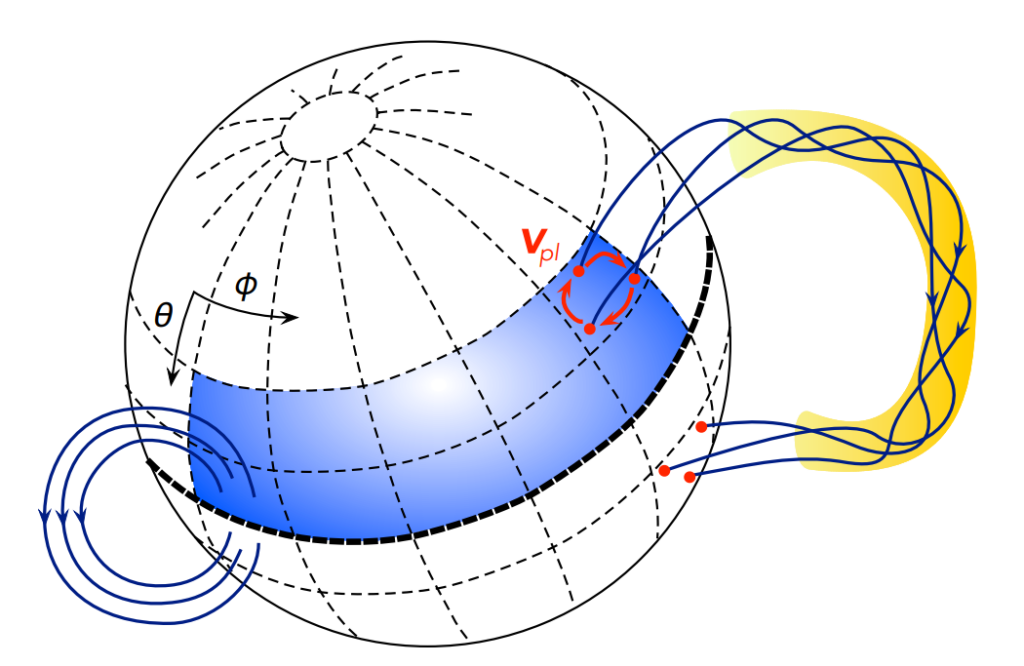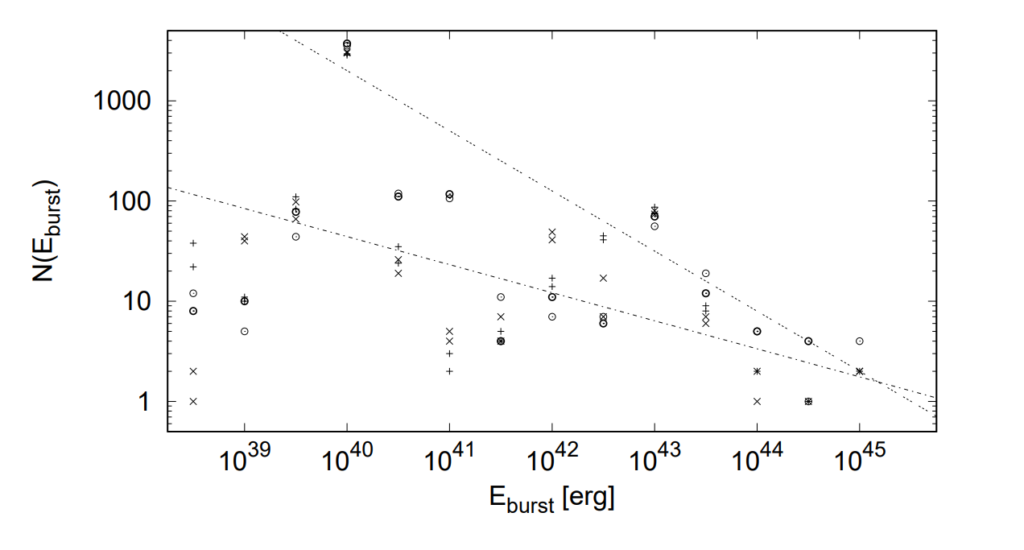Title: The game of life on a magnetar crust: from γ-ray flares to FRBs
Author: S. K. Lander
First Author’s Institution: University of East Anglia, Norwich NR4 7TJ, U.K.
Status: open access on arXiv
A bit of advice: steer clear of magnetars when they’re active.
Magnetars — highly-magnetized neutron stars, slower-spinning but more violent than their cousins, the pulsars — are endowed with both immense gravitational pulls and exceptionally strong magnetic fields; these two forces combine to fashion some ferocious fireworks. Ultralong-period radio emission, fast radio bursts, short bursts and prolonged storms of X-rays, and giant gamma-ray flares — among the most energetic events in the Universe — have all been observed originating from magnetars. While we’ve devised many piecemeal theories for how these events are independently triggered, we lack a unified model explaining how a single magnetar can produce such a plethora of pyrotechnics. The key to this problem may lie in the magnetar’s dense outer layer: the crust.
Mingling with the upper crust
While all the flares and bursts and blasts coming from a magnetar are ultimately launched from the tangle of magnetic fields in the magnetar’s corona, the free energy driving these events originates in the magnetar’s crust. Due to intense surface gravity, neutron stars possess solid crusts, much like the Earth’s outer layer — and, as we know from living on the surface of the Earth, these solid crusts are ripe for seismic activity. When too much stress is applied to a patch of magnetar crust, the patch yields, twisting and tugging on the magnetic field lines that thread that patch; this transfers energy from the crust to the corona, loading up the magnetic fields for their next big explosion.
The interplay between a magnetar’s crust and corona is complex, but an understanding of these dynamics is essential to understanding the magnetar emission we see. Unfortunately, emission from the corona obscures the crust, preventing us from directly capturing light from the magnetar’s surface; to study the magnetar crust, we must then resort to sophisticated computer simulations incorporating exotic physics, which currently require too much computing power to fully realize. The author of today’s paper strikes a compromise: modeling the crust not with fully-fledged simulations, but with a cellular automaton.
A stressful model
A cellular automaton is a “zero-player game” (arguably the most fun type of game) played on a grid of cells. Each cell can be in one of a discrete, pre-defined set of states (e.g., “on” or “off”). At each step in time, the state of each cell evolves according to a set of “cell rules” — for instance, we could define a rule dictating that if an “on” cell is adjacent to three “off” cells, at the next time step the “on” cell turns off while the three “off” cells turn on. Once the player sets the initial conditions of the grid, the automaton evolves on its own according to the cell rules.
The magnetar cellular automaton constructed by today’s author is all about stress. The author divides the crust into cells of 1 km2 in surface area, motivated by previous simulations showing localized growth of surface magnetic fields; each cell is threaded by magnetic field lines, as illustrated in Figure 1. These field lines exert stress on the cells via Hall drift, or the dragging of field lines by electrical current. When the amount of stress on a cell crosses a certain threshold, the cell yields and begins to flow — the stress changes the patch of crust from a solid to a circulating fluid, relieving the stress and eventually relaxing the cell to its original state. Therefore, a cell can exist in one of two states: a solid “elastic” phase or a flowing “plastic” phase. The author adds further complexity to the model by tracking the cell temperature and the temperature-dependent flow viscosity, which controls the rate at which plastic cells circulate and thus the rate at which plastic cells transition back to elastic cells.

With the physics in place, the author then defines two cell rules. First, each plastic cell immediately adjacent to an elastic cell exerts a shear on the elastic cell, thus reducing the yield threshold of that cell; in other words, plastic flow hastens, but does not trigger, the transition from elasticity to plasticity. Second, the presence of at least three plastic cells immediately adjacent to another plastic cell triggers a “deep crustal failure,” releasing an enormous amount of energy into the corona but resetting the stress on these cells to zero, making them effectively dormant for long periods of time.
The final piece of the model connects the energy released by the crust to the energy loaded into the coronal magnetic fields. Each circulating plastic cell continually “twists up” the field lines threading it, adding energy to the magnetic field; thus, the plastic flow rate is also the energy transfer rate from the crust to the corona. When a cluster of plastic cells relax back to their elastic phase or when a cell’s field lines become too twisted, all the energy that’s been transferred from these cells to the corona is released at once in either a short burst (for cluster relaxation) or a giant flare (for field line over-twisting).
Literally ground-breaking results
The cellular automaton works as expected, revealing some interesting trends in magnetar crust behavior. Figure 2 depicts a typical evolution of the coronal energy in the automaton, illustrating that, after many years and a handful of giant flares, the magnetar exhausts much of its energy — a majority of the crust is left dormant, only allowing for smaller bursts in the magnetar’s old age. Since young magnetars are also largely dormant (because sufficient stress hasn’t had time to build up across the crust), this implies that most giant flares come from middle-aged magnetars.

Figure 3 shows the frequency of explosive magnetar events at various energies. This reveals a vaguely downward-sloping power-law trend, much like the distribution of earthquake strengths: weaker seismic events are far more common than stronger events. The fact that the most energetic events generated by the automaton are still weaker than the most energetic magnetar events we’ve observed implies that some additional unknown mechanism is transferring energy to the corona.

While this automaton model may not be the most accurate or the most precise, it still achieves its goal of unifying the widely varying zoo of magnetar activity. In turn, this model serves as a valuable tool for comparing theory and observation and constraining the properties of these mysterious magnetars. Fortunately, we’ll have this model at the ready the next time a magnetar flare bites the crust.
Astrobite edited by: Roan Haggar
Featured image credit: science.org




